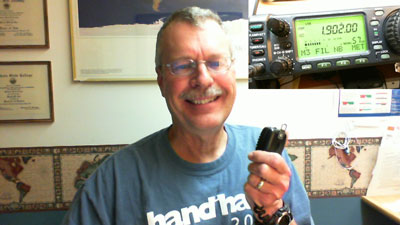Welcome to Handiham World!

Happy Autumn!
Now that autumn has returned and the equinox is upon us, conditions on the amateur radio bands begin to favor some of the longer wavelength parts of the HF spectrum like 160, 80, and 40 m. True, there is still a great deal of interference from thunderstorms that pop up in the warmer climates, but the interference isn't nearly so bad as it had been during the height of summer. The longer nights also mean less ionospheric D-layer absorption on those bands, which translates into more opportunities for long-distance contacts. In short, from this point forward we will see rapidly changing conditions on some of the bands where regional HF nets typically meet on a daily basis. This, as you might expect, can lead to potential interference as skywave propagation begins to move out from a few hundred miles to over 1000!
With more and more of our Handiham members earning their General Class tickets and becoming more involved with HF operation, we now have an opportunity to learn how the HF bands change from season to season. As always, we recommend doing plenty of tuning around and listening on the various bands to learn when there are band openings and how the more experienced operators are taking advantage of them.
One of my favorite bands has always been the 75 m band, and I have made plenty of random contacts but also enjoy checking into my favorite regional net, PICONET, on 3.925 MHz Monday through Saturday. Interestingly enough, this net has long been associated with Handihams -- way longer then I have been with the Handiham program. Propagation on 3.925 MHz during the 9 AM to 11 AM central time "morning net" is generally the best, because during the previous overnight hours thunderstorms have quieted down and the bands are generally less noisy. As the day wears on, D-layer absorption increases and signal levels drop. There is also an afternoon session, from 4 PM to 5 PM, in the summer. In the winter, the PICONET expands its afternoon session to 3 PM to 5 PM, since conditions for sky wave propagation are better. But this can pose a problem: Skywave is so good that a New York net on the same frequency can now be heard in the Upper Midwest. No doubt the New York stations are also hearing us. Generally this overlap of nets isn't a problem, but sky wave can work against you when the band "goes long" and stations from over 1000 miles away begin to sound as loud as the stations a hundred miles away. This situation calls for flexibility on the parts of net participants. If it is possible to use a directional antenna, a rarity on 75 m, interference can be mitigated by turning the antenna to favor only the stations in your area. Switching between wire antennas that favor particular directions might also help, as well as using a wire antenna instead of a vertical antenna. The wire antenna will most likely have a higher angle of radiation that will favor closer stations, while the vertical will have a lower angle of radiation that will favor the stations over 1000 miles away. Flexibility on the part of the net control stations is also called for. If interference is a problem, a net control station should consider cutting the net a little short or changing frequency just a bit. Of course this is not always easy when you have a net running and if you, as the net control station, want to change frequency everyone will have to understand the plan and change with you. It can be a challenging job for a net control station to herd everyone to another nearby frequency without having some strays!
160 m is especially useful over the winter months. While there are not as many structured nets on that band, you can run into "regulars" -- stations that often get together on the same frequency about the same time every evening. In the summer 160 m is good for propagation in a regional area during the nighttime hours. In the winter, like the 75 m band, 160 m lengthens out and long-distance contacts are possible. If you are planning to try to earn a certificate like Worked All States on 160 m, winter conditions are your friend. Most evenings at 8 PM Central Time there is an informal get-together on 1.902 MHz. Most net participants are members of the Handiham affiliated Stillwater Amateur Radio Association.
40 m is a good band summer and winter and during sunspot lows and sunspot highs. It benefits by reduced thunderstorm interference during the winter months. You can work DX on the 40 m band, and an advantage it has over 160 m and 75 m is that a wire antenna for 40 m will be able to fit into most suburban lots. Furthermore, a vertical antenna for 40 m can be quite efficient and requires less inductive reactance to make it tune, as compared to a 75 or 160 m vertical. As always, cutting ground losses through an extensive radial system will yield good results.
Of course the sunspot cycle is on the way up and we can expect more DX to appear on 14 MHz and higher frequencies, but please don't forget about 160 through 40 m. With winter conditions approaching here in the northern hemisphere, opportunities for fun on these bands are not to be missed!
I hope to hear you on the air soon.